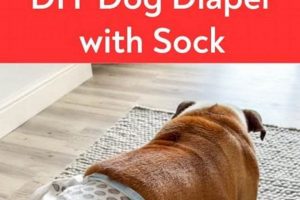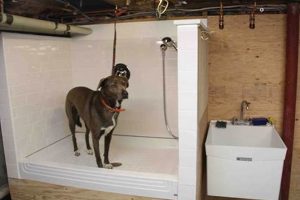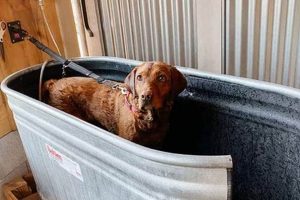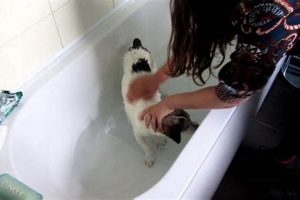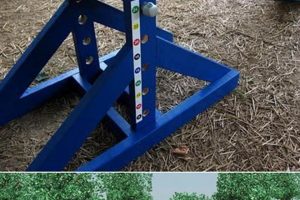Constructing protective footwear for canines at home offers a customizable solution for safeguarding paws from various environmental hazards. These homemade coverings can be fashioned from readily available materials, providing a barrier against extreme temperatures, rough terrains, and chemical irritants. For instance, a simple sock-like structure created from repurposed fabric can serve as a temporary paw protector for short walks.
The creation of custom canine foot coverings presents several advantages. It allows for precise fitting, accommodating dogs with unique paw shapes or sizes. This approach proves particularly useful for breeds prone to paw injuries or those requiring protection due to medical conditions. Historically, similar adaptations have been employed in working dog environments, such as sled dog racing, where paw protection is paramount to performance and well-being. The ability to create these items at home contributes to responsible pet ownership by providing an affordable and accessible method for paw care.
The following sections will explore materials suitable for crafting effective paw protection, detail construction techniques appropriate for various skill levels, and provide guidance on ensuring a secure and comfortable fit for the canine wearer.
Guidance for Homemade Canine Paw Protection
The following offers valuable insights for creating effective and comfortable paw protection at home.
Tip 1: Material Selection is Paramount. Choose durable, breathable fabrics that offer resistance to abrasion and moisture. Consider fleece, canvas, or tightly woven nylon for optimal protection and comfort.
Tip 2: Accurate Paw Measurement is Critical. Measure the length and width of the dog’s paw while it is bearing weight. Add a small allowance for movement and comfort to ensure a proper fit.
Tip 3: Secure Fastening Mechanisms are Essential. Utilize adjustable straps, hook-and-loop closures, or elastic bands to secure the paw coverings. Ensure the fastening system does not impede circulation or cause chafing.
Tip 4: Reinforcement of Stress Points is Recommended. Reinforce areas prone to wear and tear, such as the toe and heel, with additional layers of fabric or durable patching materials. This extends the lifespan of the protective gear.
Tip 5: Weather-Appropriate Adaptations are Necessary. Modify the design based on the anticipated weather conditions. For cold weather, incorporate insulation. For wet conditions, use waterproof or water-resistant materials.
Tip 6: Gradual Acclimation is Advised. Introduce the dog to the paw coverings gradually. Start with short periods of wear indoors and slowly increase the duration and intensity of use.
Tip 7: Regular Inspection and Maintenance are Crucial. Routinely inspect the paw coverings for signs of wear, damage, or debris. Clean and repair as needed to maintain their effectiveness and prevent injury.
Implementing these suggestions enhances the effectiveness and longevity of homemade paw protection, ensuring the dog’s comfort and safety.
The concluding section will summarize the key considerations for successful paw protection and offer final recommendations.
1. Material Durability
The efficacy of homemade canine foot coverings is inextricably linked to the durability of the materials employed in their construction. Material durability dictates the lifespan of the protection and its capacity to withstand environmental stressors. Inadequate material strength renders the coverings susceptible to tearing, abrasion, and penetration, thereby negating their protective function. For instance, using thin cotton fabric offers minimal resistance to sharp objects or abrasive surfaces, quickly compromising the integrity of the bootie and exposing the dog’s paw to potential injury. Conversely, utilizing materials such as reinforced nylon or tightly woven canvas provides a robust barrier against hazards like ice, thorns, and hot pavement. Therefore, material durability is not merely a desirable attribute, but a fundamental requirement for effective paw protection.
The selection of durable materials directly influences the overall cost-effectiveness of constructing canine foot coverings. While seemingly economical, using inexpensive, low-durability fabrics necessitates more frequent replacements, resulting in higher long-term expenditures. Moreover, the time and effort invested in creating the coverings are wasted if the materials fail prematurely. Consider the example of a dog participating in winter activities; booties constructed from water-resistant, reinforced material would provide sustained protection against snow, ice, and salt, whereas those made from less durable material would quickly deteriorate, requiring frequent replacement and potentially exposing the paw to cold-related injuries. This underscores the importance of prioritizing material durability to ensure longevity and consistent performance.
In conclusion, material durability is a critical determinant of the success of homemade canine foot coverings. Selecting robust, abrasion-resistant, and weather-appropriate materials directly translates to increased protection, extended product lifespan, and ultimately, a more effective and economical solution for safeguarding canine paws. The challenge lies in balancing durability with comfort and flexibility, ensuring the bootie not only protects the paw but also allows for natural movement and minimizes discomfort. Proper material selection ensures the homemade bootie fulfills its intended purpose: protecting the dog’s paws in diverse environments.
2. Paw Measurements
Accurate paw measurements represent a foundational prerequisite for the successful creation of effective homemade canine foot coverings. Without precise dimensional data, the resulting booties are unlikely to provide adequate protection or a comfortable fit, potentially leading to injury or refusal to wear the coverings.
- Length Determination
The longitudinal measurement of the paw, from the tip of the longest toenail to the rearmost point of the paw pad, is crucial. Insufficient length can result in constricted toe movement and potential nail damage, while excessive length can cause slippage and instability. An example of this is seen when a measurement fails to account for nail length, resulting in the dog’s toes being forced against the front of the bootie. This can lead to discomfort and even ingrown nails.
- Width Assessment
Measuring the paw’s widest point, typically across the metatarsal pads, is equally important. A bootie that is too narrow will compress the paw, restricting circulation and causing discomfort. Conversely, an overly wide bootie will lack stability and may easily slip off. Consider a scenario where the width is underestimated; the resultant bootie will pinch the paw, potentially causing chafing and hindering the dog’s natural gait.
- Circumference Consideration
Circumference measurements around the ankle, just above the paw, are necessary to ensure a secure and comfortable fit at the opening of the bootie. Ignoring this dimension can result in the bootie slipping off easily or, conversely, constricting blood flow to the paw. For instance, failing to account for ankle circumference can lead to a bootie that either slides off during activity or restricts movement and circulation, causing discomfort and potential injury.
- Accounting for Paw Conformation
Variations in paw shape and conformation must be considered. Some dogs have wider paws, higher insteps, or splayed toes. These individual characteristics necessitate adjustments to the standard measurement approach. For example, a dog with splayed toes will require a wider bootie design than a dog with a more compact paw shape, even if the overall length and width measurements are similar. Neglecting these individual paw features will inevitably lead to poorly fitting and ineffective paw protection.
The integration of accurate paw measurements into the design and construction process is paramount for creating effective and comfortable homemade canine foot coverings. Neglecting this critical step undermines the protective function of the booties and increases the risk of injury or discomfort for the dog. Precise measurements are the cornerstone of successful homemade paw protection.
3. Secure Fastening
The ability of homemade canine foot coverings to remain affixed to the paw during activity is directly proportional to the efficacy of the fastening mechanism. A secure fastening system ensures the bootie stays in place, providing continuous protection from environmental hazards. Conversely, an inadequate fastening system renders the bootie ineffective, as it will likely dislodge during movement, exposing the paw to potential injury.
- Adjustability and Fit
The fastening mechanism must permit adjustability to accommodate variations in paw size and shape. A non-adjustable system may be too tight, restricting circulation, or too loose, allowing the bootie to slip off. Consider a system utilizing hook-and-loop closures; this allows for precise tightening or loosening, ensuring a snug yet comfortable fit for a range of paw sizes. A system lacking adjustability is inherently limited in its application and effectiveness.
- Durability of Materials
The materials comprising the fastening system must withstand repeated use and exposure to environmental elements. Flimsy straps, weak buckles, or easily degraded adhesives will compromise the security of the bootie over time. For example, a fastening strap constructed from thin, low-grade nylon will likely fray and break after minimal use, rendering the bootie unusable. The durability of the fastening components is directly related to the longevity of the entire protective system.
- Placement and Design
The strategic placement of the fastening mechanism is critical to its effectiveness. Fasteners positioned too low on the leg may interfere with the dog’s gait, while those placed too high may be easily dislodged. A well-designed system distributes pressure evenly around the paw and ankle, minimizing the risk of chafing or constriction. For instance, a strap that crosses diagonally across the top of the foot and secures around the ankle provides a more secure and comfortable fit than a single strap placed directly around the leg.
- Non-Abrasive Contact Points
The surfaces of the fastening mechanism that come into direct contact with the dog’s skin must be non-abrasive to prevent irritation and discomfort. Rough edges, stiff materials, or improperly finished seams can cause chafing and potentially lead to skin abrasions. A fastening system incorporating soft, fleece-lined straps or smooth, rounded buckles minimizes the risk of skin irritation, encouraging acceptance of the bootie and ensuring long-term wearability.
The integration of a secure and well-designed fastening mechanism is paramount for maximizing the protective capabilities of homemade canine foot coverings. Prioritizing adjustability, durability, strategic placement, and non-abrasive materials ensures the bootie remains securely in place during activity, providing continuous protection from environmental hazards and promoting the dog’s comfort and well-being.
4. Weather Adaptability
Weather adaptability, in the context of homemade canine foot coverings, refers to the capacity of these protective items to perform effectively under a variety of environmental conditions. The primary purpose of dog booties is to shield paws from temperature extremes, abrasive surfaces, and harmful substances. Therefore, the design and materials must be carefully chosen to address the specific weather challenges anticipated. For example, booties intended for winter use necessitate insulation to protect against frostbite and ice accumulation, as well as water resistance to prevent saturation from snow. Conversely, booties designed for summer use should prioritize breathability to mitigate overheating and provide protection from hot pavement, which can reach temperatures detrimental to paw health. Failure to account for weather conditions compromises the bootie’s protective function, potentially resulting in paw injuries such as burns, frostbite, or lacerations.
The effectiveness of weather adaptability in homemade foot coverings can be illustrated through material selection. Booties designed for wet conditions may utilize waterproof fabrics such as polyurethane-laminated (PUL) material or tightly woven nylon with a durable water repellent (DWR) finish. These materials prevent water penetration, keeping the paws dry and minimizing the risk of skin maceration or fungal infections. In contrast, booties intended for hot weather applications might employ breathable fabrics like mesh or loosely woven cotton to promote air circulation and reduce the risk of heat-related discomfort. The choice of sole material is also critical. Rubber soles provide traction on icy surfaces, while flexible, heat-resistant soles protect against hot pavement. The practical significance of this understanding is evident in the prevention of paw injuries and the overall comfort and well-being of the canine.
In summary, weather adaptability represents a critical design parameter for homemade canine foot coverings. The selection of materials and construction techniques must align with the anticipated environmental conditions to ensure effective paw protection. The challenge lies in creating a versatile design that can accommodate a range of weather scenarios or developing specialized booties tailored to specific conditions. Ultimately, incorporating weather adaptability into the creation of canine foot coverings enhances their functionality, extends their usability, and contributes to the overall health and safety of the animal.
5. Comfort Assurance
Comfort assurance, in the realm of do-it-yourself canine foot coverings, is paramount to the successful implementation and sustained use of these protective devices. A bootie, regardless of its protective capabilities, will be rendered useless if the dog refuses to wear it due to discomfort. Therefore, prioritizing comfort during the design and construction phases is essential.
- Proper Fit and Movement
The fit of the bootie must allow for natural paw movement and flexibility. Constricting materials or poorly designed shapes can impede circulation and cause chafing, leading to discomfort and resistance. For instance, a bootie that is too tight around the ankle can restrict blood flow, causing pain and potentially leading to long-term health issues. A comfortable bootie should allow the dog to walk, run, and play without restriction.
- Soft and Breathable Materials
The materials used in the construction should be soft against the skin and allow for adequate ventilation. Rough fabrics or non-breathable materials can cause irritation and overheating, leading to discomfort and potential skin problems. An example would be using a fleece lining to prevent chafing and allowing air to circulate, preventing moisture buildup. These choices provide comfort during prolonged wear.
- Seam Placement and Minimization
The placement of seams is critical to avoid pressure points and rubbing. Minimizing the number of seams, particularly in areas that come into direct contact with the paw, reduces the likelihood of irritation and discomfort. Imagine a scenario where a seam is located directly under the weight-bearing part of the paw; this can create a constant pressure point, leading to pain and potentially causing abrasions. Strategic seam placement is crucial for comfort.
- Acclimation and Training
Even a well-designed and constructed bootie may initially cause some discomfort or anxiety. Gradual acclimation and positive reinforcement training can help the dog become accustomed to wearing the booties, reducing resistance and improving comfort levels. For example, introducing the booties for short periods indoors, paired with treats and praise, can help the dog associate them with positive experiences. A slow and patient approach is essential for long-term acceptance.
The four facets mentioned contribute significantly to whether or not a dog accepts or rejects self-made paw protection. If one facet such as seam placement is ignored, the canine may feel constant rubbing which may distract from walking and make the dog more prone to stop in the middle of a walk and attempt to take off the booties. Prioritizing comfort will greatly increase successful adoption of self-made paw protection.
6. Regular Maintenance
The long-term efficacy and safety of homemade canine foot coverings are directly contingent upon diligent regular maintenance. Without consistent inspection, cleaning, and repair, these protective devices are prone to degradation, rendering them less effective and potentially hazardous. This interdependency underscores the significance of integrating regular maintenance into the lifecycle of constructed canine foot coverings as an essential component of responsible pet care. The accumulation of dirt, debris, and moisture within the fabric matrix can lead to the development of bacteria and fungi, creating an environment conducive to skin irritation or infection. Additionally, wear and tear, such as frayed seams or weakened fasteners, can compromise the structural integrity of the bootie, leading to slippage, loss of protection, or even entanglement that could cause injury. Therefore, neglecting routine maintenance precipitates a decline in performance and elevates the risk of adverse health outcomes for the canine wearer.
The practical application of this understanding necessitates the establishment of a regular maintenance schedule. Following each use, the booties should be inspected for damage, cleaned to remove dirt and debris, and thoroughly dried to prevent the growth of microorganisms. Repairs should be addressed promptly, mending frayed seams, replacing worn fasteners, and reinforcing areas prone to stress. For instance, consider a bootie constructed for winter use; exposure to road salt can accelerate fabric degradation and cause irritation to the dog’s paws. Regular washing with a mild detergent removes salt residue, preserving the integrity of the material and mitigating potential health risks. Similarly, inspect fasteners, such as hook-and-loop closures, as dirt and debris reduce their effectiveness and may require manual extraction or even replacing the fastener to maintain the bootie’s function. The frequency of maintenance will depend on the intensity of use and environmental conditions, but a proactive approach is vital to ensuring the continued effectiveness and safety of the coverings.
In conclusion, regular maintenance is not merely an ancillary task but an integral element of utilizing do-it-yourself canine foot coverings. By adhering to a consistent schedule of inspection, cleaning, and repair, the lifespan of the protective devices is extended, and the risk of paw injuries or infections is minimized. The challenge lies in consistently prioritizing maintenance amidst other pet care responsibilities. However, the long-term benefits, including enhanced protection, improved hygiene, and reduced veterinary costs, outweigh the effort required. The conscientious commitment to regular maintenance ensures that canine foot coverings remain a safe and effective tool for protecting canine paws in diverse environments.
Frequently Asked Questions
The following addresses common inquiries regarding the construction and utilization of homemade canine foot coverings, providing clarity on their application and effectiveness.
Question 1: Are homemade canine foot coverings as effective as commercially manufactured products?
The effectiveness of homemade coverings is contingent upon material selection, design precision, and construction quality. While commercially available options may offer specialized features or materials, well-crafted homemade versions can provide comparable protection for many applications.
Question 2: What materials are most suitable for creating waterproof canine foot coverings?
Waterproof or water-resistant fabrics such as polyurethane laminate (PUL), coated nylon, or tightly woven polyester are appropriate choices. Seam sealing may further enhance water resistance.
Question 3: How can one ensure a proper and secure fit for homemade canine foot coverings?
Accurate paw measurements are essential. Adjustable straps, elastic closures, or hook-and-loop fasteners can accommodate variations in paw size and shape, ensuring a snug but not constricting fit.
Question 4: What is the best method for introducing a dog to wearing foot coverings?
A gradual acclimation process is recommended. Begin with short periods of wear indoors, pairing the introduction with positive reinforcement, such as treats and praise. Gradually increase the duration and frequency of use.
Question 5: How often should homemade canine foot coverings be cleaned and maintained?
Regular cleaning is recommended after each use, especially if the coverings have been exposed to dirt, moisture, or salt. Inspect for damage and repair as needed to maintain their integrity.
Question 6: Are homemade canine foot coverings suitable for all breeds and paw types?
While adaptable to various breeds, specific paw conformations may require customized designs. Dogs with particularly wide paws, splayed toes, or sensitive skin may necessitate modifications to ensure a comfortable and effective fit.
The construction of effective canine foot coverings requires careful consideration of material properties, design principles, and the individual needs of the dog.
The subsequent segment will summarize the key advantages and disadvantages of homemade canine foot coverings.
Conclusion
The preceding exploration of “diy dog booties” underscores the potential for crafting custom paw protection solutions at home. Effective implementation hinges upon meticulous attention to detail, encompassing precise paw measurements, durable material selection, secure fastening mechanisms, and adaptability to varying environmental conditions. Prioritizing canine comfort and adhering to a routine maintenance schedule are also essential for maximizing the efficacy and longevity of these homemade protective devices.
While commercially manufactured alternatives offer convenience and specialized features, the creation of homemade canine foot coverings presents a viable and often cost-effective option for responsible pet owners seeking to safeguard their companions’ paws. Further research and experimentation in material science and design may yield increasingly sophisticated and durable homemade solutions. Continued diligence and adaptation remain crucial for ensuring the well-being of canines in diverse and challenging environments.


